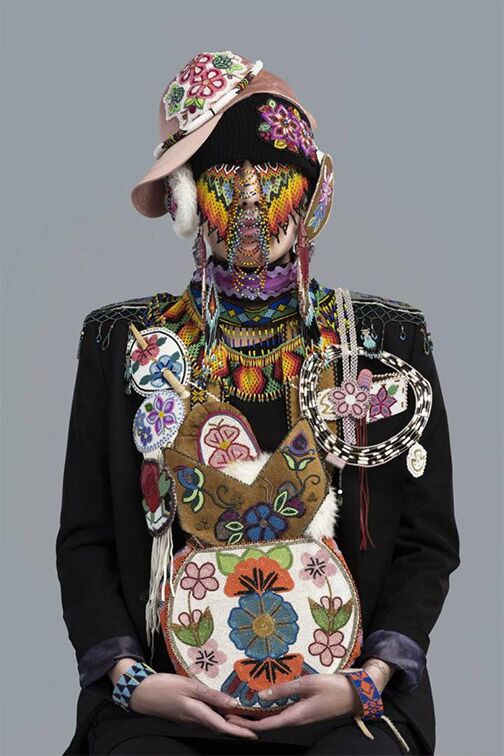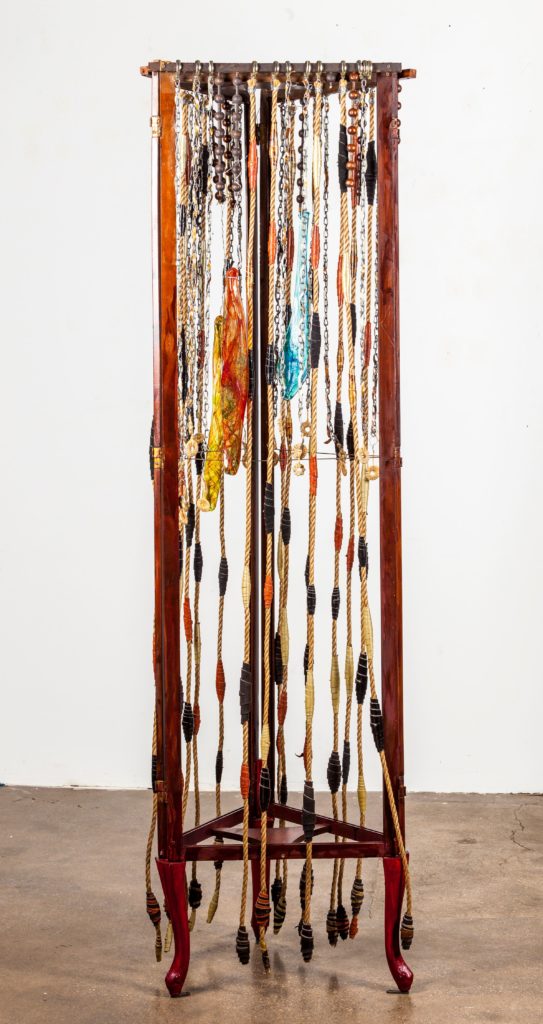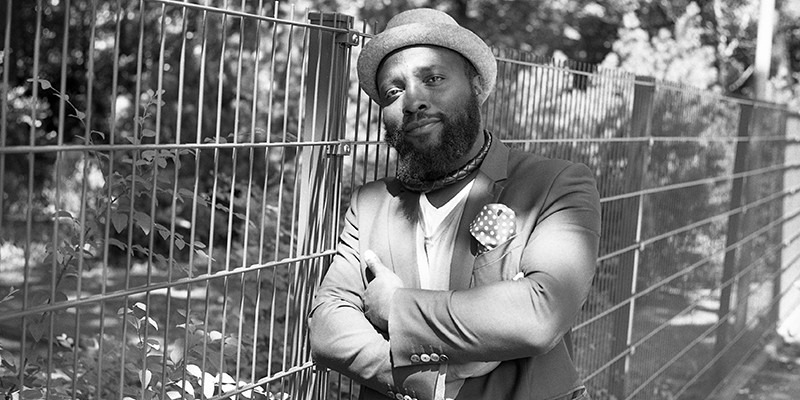The development manager for the Toronto Biennial of Art which is running from September 21 until December 1, Maher has worked as a grant writer and curator at various Toronto-based art institutes including the Art Museum at U of T and The Power Plant. Partners in Art is a funder of the Biennial.
How did your career in art begin?
My mom is an artist and attended Central Saint Martins in London, studying painting and printmaking. Afterwards, she was a high school art teacher, so I grew up with a strong creative influence. As a child and teenager I was highly engaged in the arts but more from the producer end, as we didn’t really have art history available in my high school. I really loved painting and making these funny abstract quilts of my favourite 90s’ heroes.
I ended up following my interests in journalism and global affairs into university. It was while I was doing my undergrad at U of T that I decided to take a modern art history course – art since World War II – as an elective, that I began seriously considering the visual arts as a career stream. I ended up leaving school only to return a few years later; by then, there was only one area of study that made sense: visual arts.
It was really my job at the AGO in the Prints and Drawing department that opened my eyes to the array of career possibilities in the arts, and Barbara Fischer, the curator and executive director at the Art Museum at the University of Toronto, who pushed me to be brave and follow my talents.
When did you know you’d have a career in art?
I have never viewed my life, or career, as linear or sequential, so while I may be working in the arts now who knows what will come next. Finding work outside of academia can be tough and I had to hustle and push through many contracts and part-time gigs to find an iota of stability in the arts.
I think I knew that I was in this for life because, despite all the hardship and struggles, art is the thing that gets me out of bed in the morning. It is also the one thing which never bores me.
What was your first successful art project?
Success is important but so is failure. Failure is part of the creative cycle and always has been a great fascination of mine. There was an incredible show at the National Gallery in Washington years ago, with John Cage, Chuck Close, Amy Sillman, Sol LeWitt and Julie Mehretu, titled Yes, No, Maybe, which beautifully captured the artistic process and how our failures are as much a part of our best as our successes. Sometimes we should yearn for them as much because they show us the better path.
All this to say, my first success was mounting the retrospective on David Buchan at the Art Museum at University of Toronto in 2014. Introducing new audiences to his work and an era of the Toronto art scene that is so important to our country was rewarding, as was working with and meeting many of the artists who helped make Toronto the cultural centre it is today.
What do you consider your greatest achievement?
Staying curious, and being constantly surprised by life and its wonders.
In reflecting on your career, what is the common thread throughout?
Taking on ambitious crazy projects. I’ve never backed down from a challenge and I believe nothing worth doing is easy. That, and decisions guided by instinct, emotion and lived experience. Connection is key with me.
What do you do if you need inspiration?
Get out of the city and find solitude. Being by the water and listening to nature. Finding places that let me breathe, walking and spending honest time with those I love; and sometimes galleries.
Which artists do you admire most?
There are so many but those who have been constants in my life: Marcel Duchamp, David Hockney, Lucian Freud, Joan Jonas, Francis Bacon, Faith Ringgold, Gerhart Richter, General Idea, Rebecca Belmore, Joyce Weiland, Matisse …

Younger artists who have caught my heart in recent years include Wu Tsang, Geoffrey Farmer, Jonathas de Andrade, Dana Claxton, Maria Hupfield, Kehinde Wiley, Jason de Haan, Ed Atkins, Shuvinai Ashoona, Lynette Yiadom-Boakye … I could go on forever.
Is there an artist that you like that would surprise people?
Caravaggio is my main man, he’s been a fascination from my early days. I am a huge fan of the Dadaist, especially Kurt Schwitters. Some of the most inspiring work I have ever experienced is the women of Gee’s Bend and their quilts which predated abstract expressionism and were revelations. When David Mirvish brought them to Toronto and showed their works at Books on Art on Markham, that was a moment I will never forget. And, that I prefer Borromini over Bernini?
What advice do you have for aspiring curators?
Work with artists and listen to them, and then take 10 steps back. Consider the process and what happens in the spaces between the idea and the object. Sometimes the journey is as important, or even more interesting, than the final result. Don’t take yourself (or art) too seriously. Appreciate pop culture, read the news and learn to write grants. Be human.
Who would you want to create your portrait?
Either Caravaggio, Lucian Freud, Suzy Lake or Robert Mapplethorpe.
You worked as a collection assistant for the Estate of General Idea. How did that position influence you?
I’m a huge archive nerd and I love books, zines, postcards, letters; objects that create a line of communication and the opportunity for reciprocity. I think Moyra Davey’s work is fantastic in this way.
General Idea has come to represent a lot of what I was searching to find in myself and in Toronto when I moved here 20 years ago. I’ve always had a deep respect for those who make their own destinies and, as a constant outsider myself, GI embodies the idea that we are in full control of who we want to be and that, if we want to be fabulous and glamorous and amazing, then we can be. We create our own mythologies. They created spaces for people to come together and make a community; they didn’t rely on outside approval to embrace their own worth.
There was such urgency to the Toronto art world then, in the late 70s through the early 90s, and the best parts of this city were founded in those years. The resiliency and compassion that carried people through the AIDS crisis; that kind of love and dedication is something we need more of everyday, without that level of human tragedy.
Working on David’s show and then being able to work at Art Metrople and, in turn, on AA Bronson’s collection, was a magical period in my life, and I’m really excited to see AA working with Adrian Stimson on a very special project for the 2019 Biennial.
You have been working on the Biennial for over a year. What have been the highlights and challenges?
It’s a crazy project! But as I mentioned, I never back down from a challenge and the opportunity to be a part of something at its foundation is something I couldn’t say no to. Plus, we have amazing festivals for film, music and theatre – it’s time to celebrate the visual arts! Toronto is an amazing city, and Canadian artists are some of the most dynamic, interesting and talented working today so is time we celebrate our artists, at home.
The main challenges that I have faced have had to do with the limited opportunities to fund innovative, new projects in the cultural sector. We have a bold, ambitious vision for the Biennial, and starting something new is always hard. Luckily we have amazing supporters who want a better future for Toronto and believe the arts are good for everyone.
Working with the amazing team at the Biennial is definitely a highlight; I’ve learned so much and made wonderful friends. It’s also expanded my understanding of what I am capable of, and what happens when great people are brought together, what they can achieve.
Absolutely the most exciting part is the exhibition and programs. Working with wonderful artists and supporting the creation so many new works via commissions; it’s inspiring to support those ideas and visions, and see the works develop in dialogue with our city and communities. Bringing exceptional and world-class art to Toronto, for free. There isn’t anything else that rivals the amount of artists, works and the breadth of programming (for 72 days!!) in North America today, it is so inspiring.
The bold and revolutionary take on public programs our team has taken: Ilana Shamoon, Clare Butcher and Myung-Sun Kim have worked tirelessly to bring events and activities that will activate the Biennial for the entirety of its 10 weeks in ways that are completely unexpected.
What are you most excited about for this year’s Toronto Biennial of Art?
Everything! I am biased to be honest, but this event is truly impressive. There is such a variety of artists, programs and events I’m hoping we can capture the imagination of all visitors, art-lovers and newcomers alike. I think we will all learn more about our city and the lands we share, opening up new ways of seeing but also new ways of being together. The strong representation by Indigenous artists, creators and knowledge-keepers is definitely a major highlight for me personally.

There are definitely some artist projects which I’m particularly excited for: Althea Thauberger & Kite’s performance and film Call To Arms in collaboration with the HMCS York is a standout, as are projects by Susan Schuppli, Dana Claxton, New Mineral Collective, New Red Order, Embassy of Imagination, Jae Jarrell and BUSH Gallery with Lisa Meyers – they’re throwing a beach party on the Toronto Islands. Curtis Talwst Santiago is taking a huge step in his practice and creating a large-scale installation near Cherry Beach which is going be wild, and projects by Harbour Symphony with Raven Chacon and Delf Maria Hohmann, water and astrology programs by Elder Duke Redbird at Ontario Place and Storytellings by Borelson also top my list.
Rethinking how art institutions and artists engage with audiences helps us break down barriers and make art more accessible, and the events they’ve planned really push the boundaries of how we understand artistic engagement.
How did you hear about Partners in Art
I first was introduced to PIA during my time at The Power Plant, where PIA supported the Creative Time Summit in Toronto, as well as Karla Black’s massive sculptural installation, as well as PIA’s incredible sesquicentennial project Landmarks2017/Repères2017.
